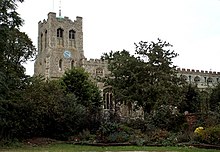Coggeshall is a town of 4,700 people (2011) in Essex on the River Blackwater. It has almost 300 listed buildings and a market whose charter was granted in 1256 by King Henry III.
Understand
edit
Coggeshall was a Saxon settlement on the Roman road Stane Street, though the area has been settled since the Mesolithic period. There is evidence of a Roman villa or settlement before then and the town lies on Stane Street, which may have been built on a much earlier track. The drainage aqueducts of Stane Street are still visible in the cellar of the Chapel Inn today. Roman coins dating from 31 BC to AD 395 have been found in the area and Coggeshall has been considered the site of a Roman station mentioned in the Itineraries of Antoninus.
Coggeshall is situated at a ford of the River Blackwater, part of another path running from the Blackwater Valley to the Colne Valley. Where these paths crossed a settlement started.
Get in
editBy car
editOn the A120 between Braintree and Colchester.
By bus
editFirst Essex number 370 between Chelmsford and Colchester (via Braintree) stops in the town every 30 minutes Monday–Saturday and every two hours on Sunday (2022).
Get around
editSee
edit- 1 Coggeshall Grange Barn, Grange Hill, CO6 1RE, ☏ +44 1376 562226, coggeshall@nationaltrust.org.uk. Grange Barn was built by the Cistercians in the 13th century to serve the abbey. It is one of the oldest surviving timber-framed buildings in Europe. It survived the Dissolution of the Monasteries, remaining in continual agricultural use up until 1960 when it was left derelict. It has undergone extensive reconstruction and its original thatch roof has been replaced with tile. Grange Barn is open to the public showing a collection of farm carts and wagons. Adult £7, child £3.50.
- St Nicholas' Chapel. Coggeshall Abbey's gatehouse chapel is the oldest surviving post-Roman brick building in the country (c. 1220). It survived the Dissolution of the Monasteries intact, albeit converted into a barn. It was restored in 1863. The original bricks from the ruins of the abbey are older still, and were made by the monks themselves. These were believed to be the oldest post-Roman bricks in the country; however, brick making was not reintroduced to Britain by the Cistercians, but that there was already a brick making industry around Coggeshall in the early 12th century, prompted by the exhaustion of the supply of recyclable Roman bricks.
- 2 Church of St Peter-ad-Vincula (St Peter in chains). It is one of the largest churches in Essex (internal dimensions of 134 ft 6 in by 62 ft 9 in, or 41 m by 19 m; the tower reaches a height of 72 ft or 22 m). The present church was built in the perpendicular style with 'wool money' during the first quarter of the 15th century; its unusual size is testament to the affluence of the town at the time. On 16 September 1940, the Luftwaffe bombed the church causing the roof of the nave to collapse and significant structural damage; repairs were completed in 1956.
- 3 Paycocke's House. Paycocke's house was built in or around 1500 by John Paycocke. The house features elaborate wood panelling and carvings, a testament to the wealth generated by the wool trade in East Anglia. Restoration work was carried out in the 1960s and the house is now open to the public.
- The town clock was built to celebrate Queen Victoria's jubilee in 1887 and the clockhouse was at one point a school for the poor children of the town and later housed an award-winning tearoom. It is a wine bar.
- Nunn's Bridge, a wrought iron footbridge on a Public Right of Way crossing the River Blackwater was erected in 1892. It is unique in its design, and was made and installed by local blacksmith and social campaigner Henry 'Dick' Nunn after the previous wooden bridge was washed away and authorities refused to replace it.
Do
editBuy
editEat
editDrink
editSleep
edit
- 1 White Hart Hotel, Market Hill, CO6 1NH, ☏ +44 1376 561654.

